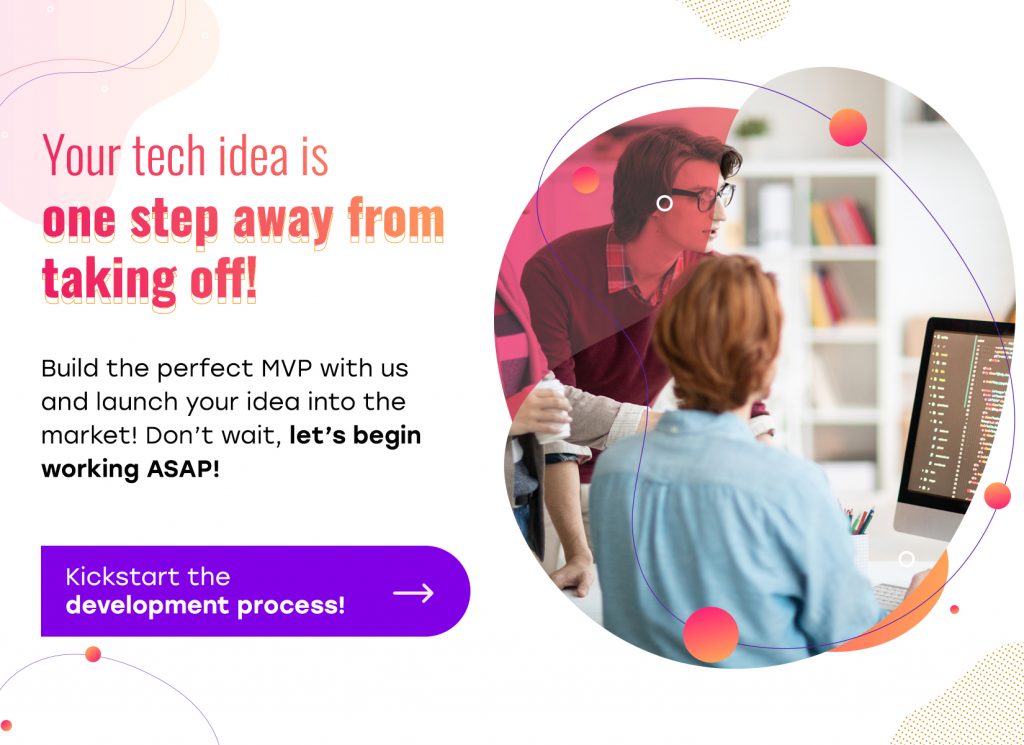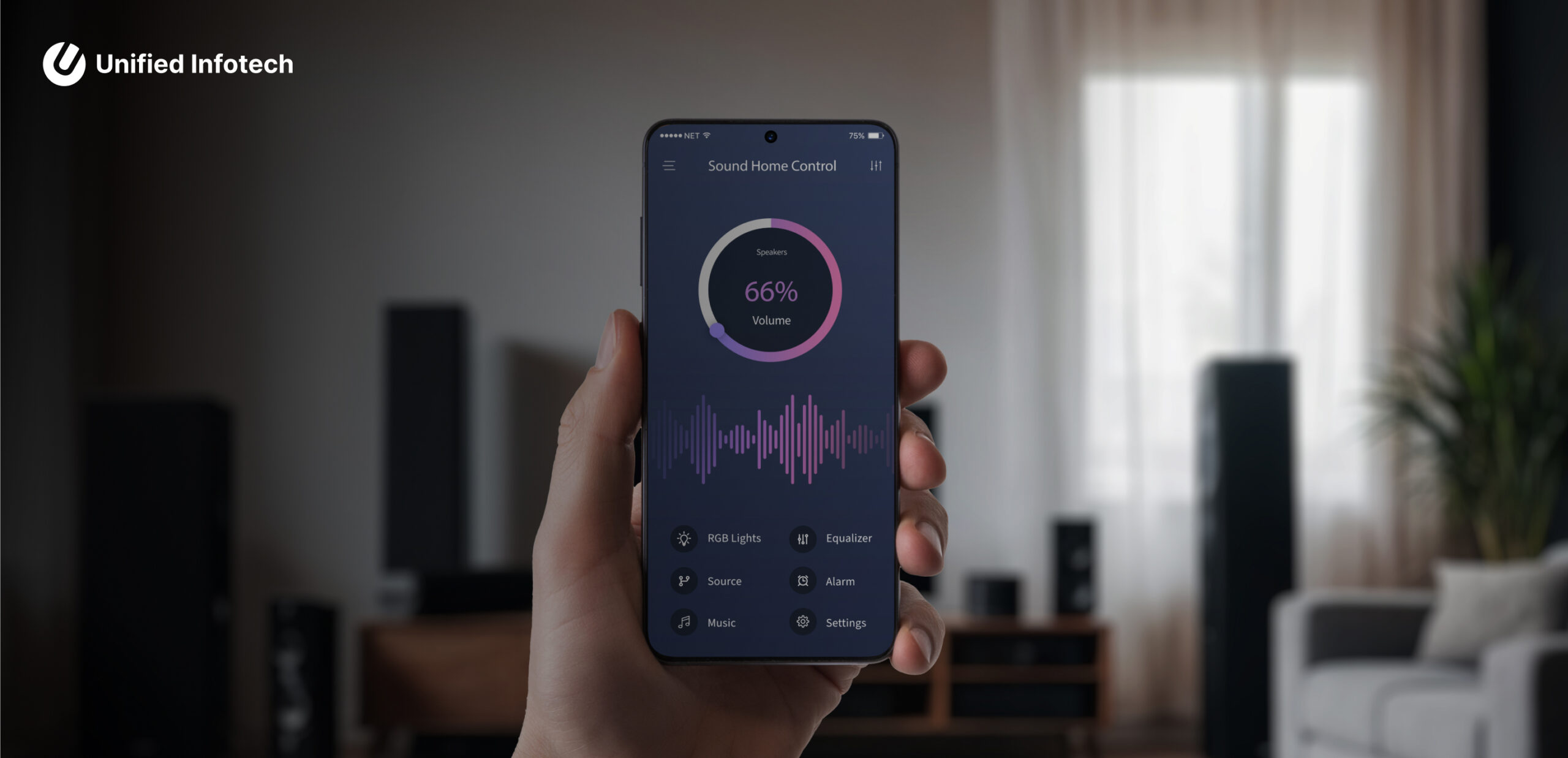
Site Search
All About That MVP: Getting Your Tech Idea Off The Ground

Table of contents

Let's talk
Reach out, we'd love to hear from you!
Let’s talk about Quibi, the American short movie platform.
The ambitious streaming platform, launched in 2020 April, was made for people on the go. It offered shows with 5-10 minutes long episodes. It garnered a lot of attention, and even a massive $1.75 billion investment. But its journey was cut short in December 2020 due to a lack of subscribers.
A later post mortem revealed the main reason for Quibi’s failure- the lack of an MVP approach. The platform tried to compete against streaming service giants during the height of pandemic times, with a not-so-unique idea. Had they used an MVP software development approach and assessed the market before launching, the story might’ve ended differently.
MVP development enables you to launch a product with minimal features, enough to fulfill the basic needs of the users. This way, you can gather data on consumers, the market, and validate your business idea before investing more resources. Remember- to avoid disastrous endings like Quibi, an MVP approach is mandatory.
But how do you proceed with MVP software development? Let’s unravel the secrets of this approach one by one in the following points.
1. The Distinctions Of The MVP Software Development
One search online would reveal that there are all sorts of minimal approach terms related to MVP. So before we get started on the discussion of how do you develop an MVP, let’s look at these related terms and consider how they relate to each other.
A. MVP [Minimum Viable product]
The first and perhaps the most popular minimal approach is MVP.
Used first in Eric Ries’ book Lean Startup, an MVP product development is a perfect approach for you to validate your business idea. It is not the first version of your digital product, rather a platform with minimal features, coding, and design. This can be a landing page that helps you learn about what kind of consumers are attracted to your business. Additionally, it can also be an app with a basic feature aimed at solving a core problem of the users.
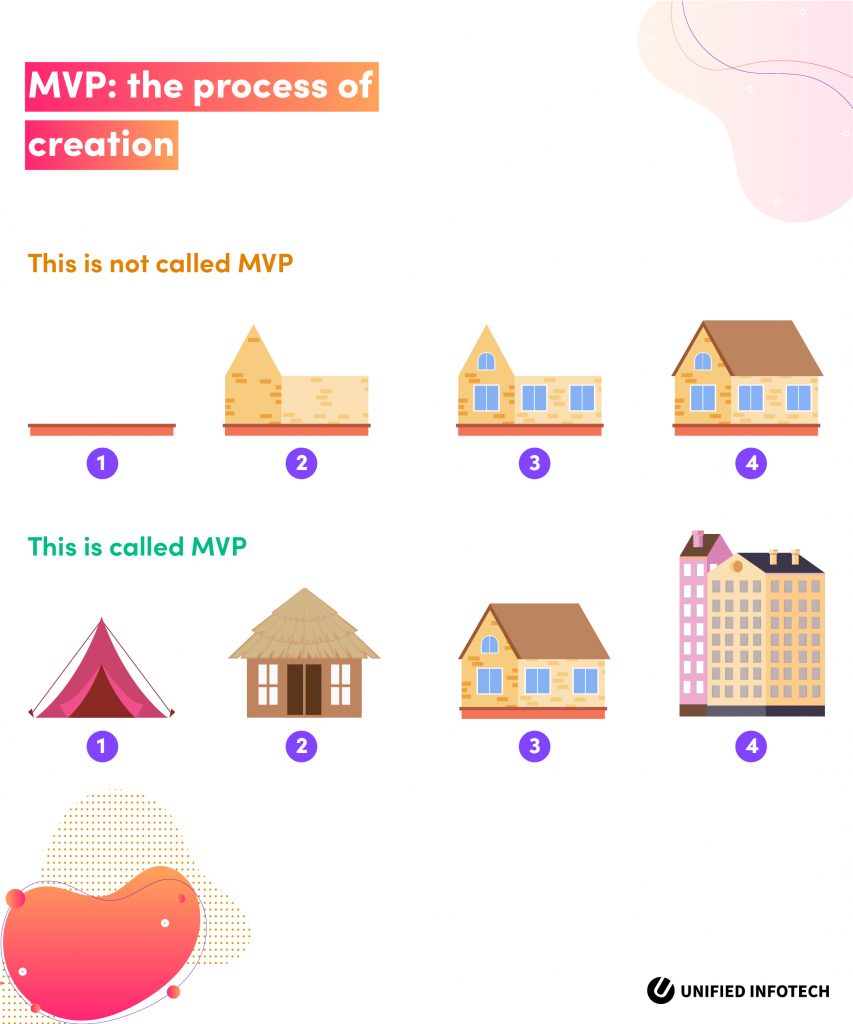
The MVP is in no way meant to be a long-lasting solution. It is part of the B.M.L method. One is supposed to build an MVP, measure the feedback gathered from it, learn from that accumulated feedback and then enhance the platform with that learning. It helps the entrepreneurs to understand the unique problems the users are facing, and come up with unique solutions.
B. MMP [Minimum Marketable Product]
MMP, also known as minimum marketable product or minimum shippable product, happens to be similar to MVP, but a little different at the same time.
While the approach of minimal resources and effort investment stays the same, the approach towards the longevity of the platform changes. An MVP app development is only supposed to be used for experiment and feedback gathering purposes. On the other hand, MMP is supposed to provide real value to the users, from the very initial stage.
Created using some must-have features, an MMP is a digital product that can be marketed and sold to the users out there. Whether it is a web app development or a site, with such a platform, users can complete the task they set out to do, and entrepreneurs can gather data and earn revenue at the same time. An MMP is simply the marketable version of the MVP approach.
C. MDP [Minimum Desirable Product]
Minimal desirable products are one step ahead of the MVP approach.
While the MVP services come with many benefits, you can hardly excite and attract users with them. Even with an MMP approach, the best you’d be able to do is to gather more feedback from the users on what more features the product needs. Very few would stick around until the platform becomes better, most will leave without a second glance.
With the minimum desirable product, you can use exciting UX/UI elements to hook the users from the beginning, no matter how little the platform does. The additional aspect of user-centricity turns the simple MVP into a minimum valuable product. The MDP approach will help you to attract and retain users from the very beginning.
2. The Relations Between The Minimal Approaches: A Brief Overview
If you are thinking that it doesn’t really matter which one of the above approaches you choose, then think again.
Despite being closely related, the three kinds of minimal approach have their own distinction as well. So let’s explore exactly how they are related, and how they differ.
A. The Relationship
Let’s look at the relationship first.
MVP, MDP, and MMP are the steps of the MVP software development process to create a product that is ready for launch.
Through careful MVP solutions are created and launched into the market to accumulate user feedback. This feedback not only consists of data on what type of consumers are being attracted to the platform. It also contains information on what kind of features, UI/UX requirements they are looking for, as well as the extra value that might retain them for a long time.
Heeding this feedback, the developers can enhance the platform, the MVP user experience, and improve the overall experience to make the product more desirable, therefore more prone to success. From here it is only a few modifications away to turn it into a minimally marketable product that can be officially launched into the market and earn revenue.
B. The Differences
There are multiple differences between the three MVP software development approaches.
From the main purpose of development to the time and cost, all these differences make the MVP solutions vary widely from one another. And these differences are also the reason why most companies tend to choose a singular minimal approach.
Here’s a compact look at all the major differences between MVP, MDP & MMP-
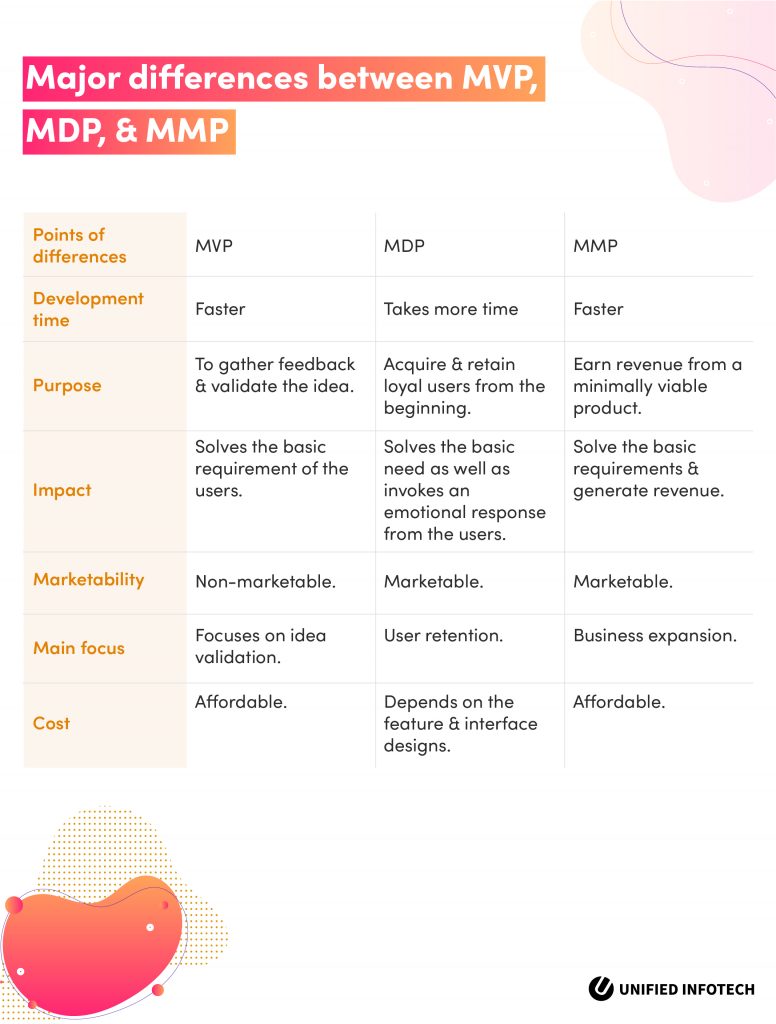
Now that you have a comprehensive idea about the relationship and differences between the three kinds of minimal approach, it’s time to talk about the perfect process of developing an MVP.
3. How To Develop The Perfect MVP: Our Process
Many consider MVP to be dead. On the other hand, many think startup MVP development is the only way to launch an idea into the market.
But which opinion is the right opinion?
Well, as the tech partners of numerous ideas that achieved staggering progress in their industry, we can vouch that the MVP approach is truly, not dead. But the process of MVP development has changed. Previously, entrepreneurs would take the most minimal approach while developing, resulting in a product that barely fulfilled user needs. The hyper fixation with minimalism in MVP software development has changed now. More and more web development companies these days are focusing on creating a viable product with minimal effort so that the initial business requirements can be fulfilled.
A. Kicking Off With A Look Into The Market
A product, digital or not, must fit into the kind of needs and wants the target users to have. Failing to do so will result in catastrophic failure. According to research, more than 42% of times a startup fails because their product was not needed in the market.
As an experienced MVP development company, we begin with a complete market analysis. The research includes the core problem the digital product is aiming to solve, the already available solutions in the market, how they serve or fail to serve the target demographic, and what kind of unique valuation the users are looking for.
More information means better chances of success right off the bat. Knowing the market, the users, and the competitors gives us and our clients a solid foundation, to begin with. This way we can determine what the minimum viable product software development needs to succeed.
B. Consider The Value Addition
The prevalence of digital solutions has made it almost impossible to break into the market successfully. There are simply way too many solutions for one problem, all of them more or less the same.
And that’s why the next step of MVP project management & development is the value addition/idea validation.
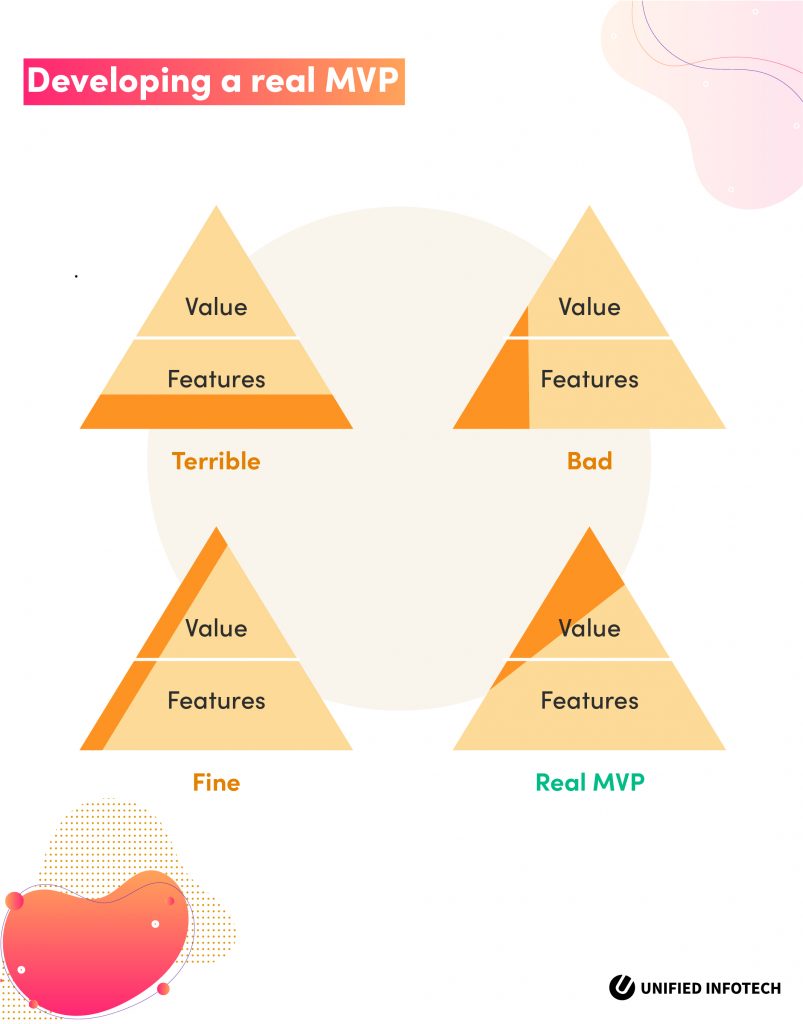
The MVP software development stage is all about giving the target demographic the first taste of your unique idea that solves problems more efficiently than other solutions available. And that’s why despite it being the minimal effort stage the idea needs to be implemented well.
In this stage, we take a look at the possible competitors, and what they are doing. This way we can pinpoint the exact gaps left by the industry rivals and how the solution can fulfill those gaps. After creating a one-of-a-kind value offering document for the idea, we then move onto the next stage of the MVP development, which is mapping the user flow.
C. Mapping Out The User Flow
Granted that MVP product development includes only the basic features and functionalities. But that does not mean it is okay to completely ignore the design flow. To understand the unique offering which is your idea, the users need to be able to use the platform (app or web) properly. And this is where the third stage comes in.
Our process of building a minimum valuable product includes a user-centric point of view where we first document the major pain points they face while trying to solve a problem using one of the existing solutions. And then we design a user flow on the MVP platform that solves the pain points and empowers them to fulfill their tasks.
In this stage, we make use of our UX & web design expertise and map out an intuitive user flow from the beginning to the end of the journey on the platform. Our design teams implement design best practices and policies that give the platform a polished experience from the first stage.
D. Set The Feature Priorities Right
The key stage of MVP development, feature sorting is one of the many things that determine how successful the minimally viable product is going to be. Failing to decide on the essential features during this stage can put the entire future of the product at risk.
Out of the many methods of prioritizing features, we stand by the user story mapping process. A part of our MVP agile development process, it helps us to list the essential MVP features that help the product accomplish its goals.
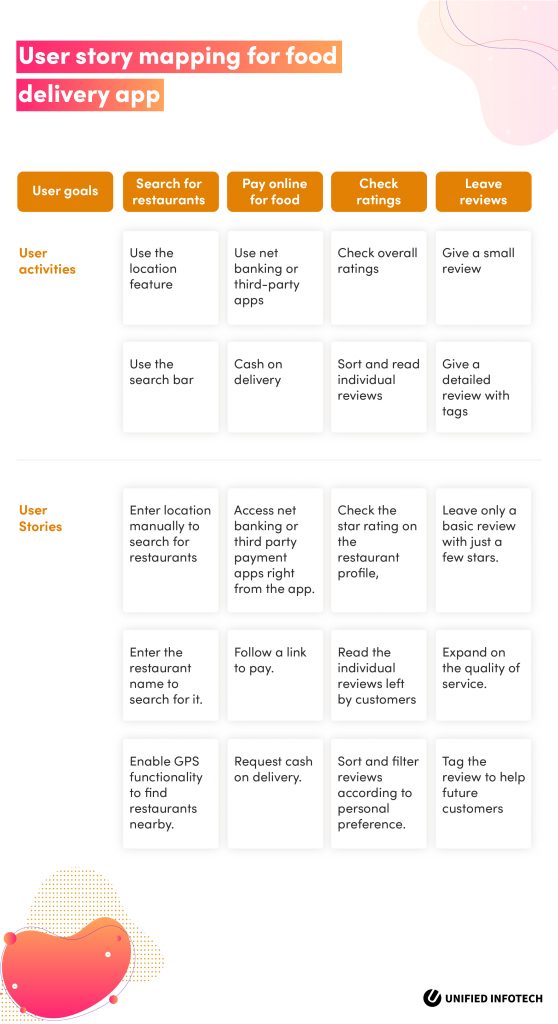
Here’s how we approach the feature sorting process with our well-defined user story mapping process-
Step 1
We begin with the goals the user wants to accomplish with the digital product. Whether it is signing up on the platform, or performing any other task- we start by listing out the possible goals the product will help the users to achieve.
Step 2:
Once we have listed the goals, we divide them into activities. The activities are the tasks a user must complete to accomplish their goal- like registering with the right credentials to create an account on the platform.
Step 3:
After the activities are assigned under each goal, it is time to break down the activities into smaller user stories. These user stories are various actions users perform on the platform to achieve certain goals. During MVP development, these stories are sorted from the highest priority to the lowest priority accordingly.
E. Follow Through With BML (build, measure, learn) Model
An MVP is in no way the final product. No matter how desirable experience it offers or how much revenue it is earning from the day it was launched, you must continuously improve the product through MVP programming. And that’s why this stage is an integral part of our MVP development lifecycle.
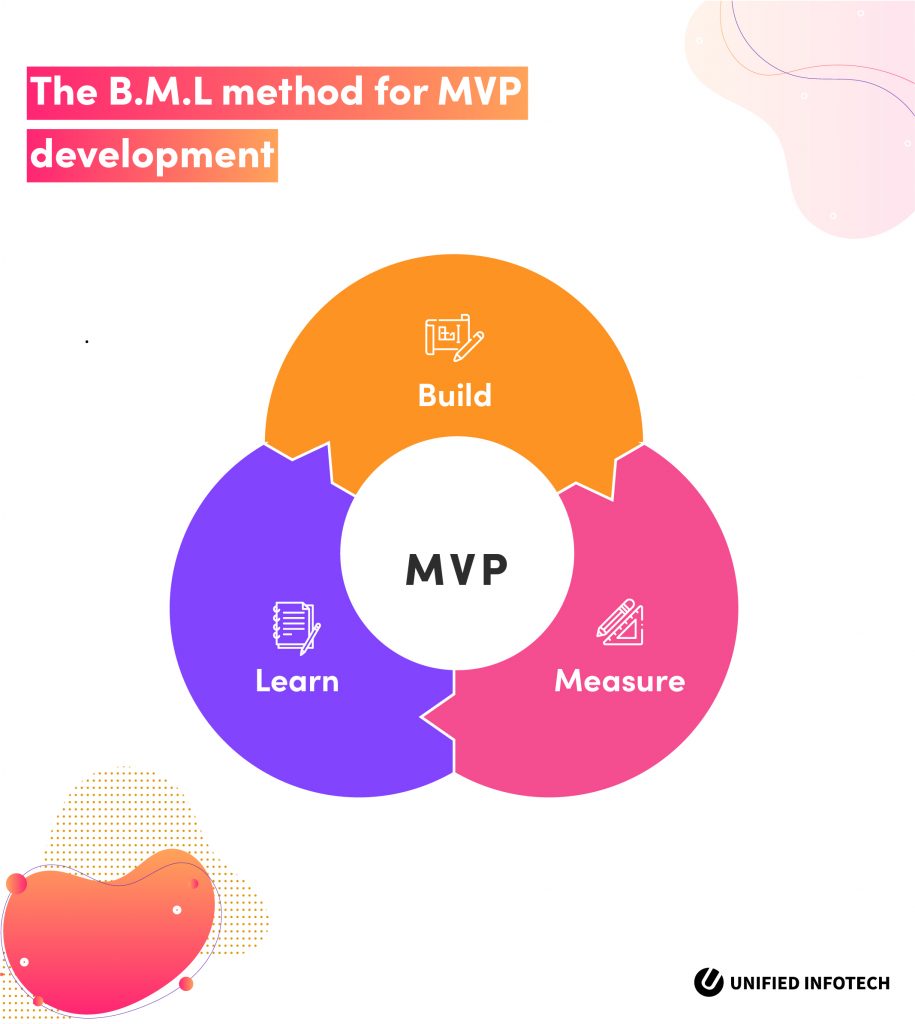
As one of the skilled MVP development services in the industry, we measure the impact made by the product once it is launched into the market. This measuring process provides us with insight into how well the product is helping the audience, where it is failing, and what more the audience expects from it. With all this information, we get back to work again and start implementing the acquired knowledge to improve the platform for the better.
The entire process, from the first stage to the last, is conducted by keeping the users & business goals in mind. The success of the MVP process depends on striking a harmony between the two, and our process adheres to that rule at all costs.
4. MVP Benefits: Why Should You Even Go Through All The Trouble?
Why even go to all the trouble?
Why not develop the entire platform in one go, launch it into the market, and hope for the best? Well, doing so will seriously hurt the chances of business success. And that’s why it is better to go for an MVP software development approach at the initial stages of the development.
Here are a few more MVP business benefits to convince you about the effectiveness of this approach.
A. Affordability
First comes the benefit of affordability.
Whether you happen to be a startup entrepreneur or an established business owner, your aim must be to get your tech initiatives off the ground with minimal waste of resources. And for that MVP is the perfect approach. Affordable MVP development cost, in combination with the iterative process, makes for an encouraging environment for the development and success of your tech idea.
B. Validating The Market Demand
One of the major reasons for business failure is having little to no market demand for the product you are trying to sell.
Sure your idea may be unique, and it may be able to help the people, but is there a market for it? The MVP programming, which begins with comprehensive industry analysis will save you from all the market failure-related trouble. You can get access to information on what kind of digital solutions already exist, how they help the users, and how your solutions are different. Having and using all this information, you have a better chance to succeed in the industry.
C. Testing Out The Business Concept
Launching the idea without testing it is like taking a blind leap off of a mountain cliff. The idea and business revenue model should go through rigorous testing before the launch. And once again MVP app design offers you the time window to test the business concept, tweak it for better results, and then launch it when you feel like it will generate the expected results.
D. Examining The Impact Of The Product
The MVP prototype helps to understand the kind of impact the product will have on the target market. After launch, we apply the B.M.L method and measure the impact of the platform on the target users. This information will then help us to improve the product and enhance its future impact on the industry and users.
E. Building An Early Relationship With The Customers
Modern businesses and solutions must be customer-centric to succeed. With MVP product management, one can build an early connection with the target consumers. With their feedback, the consumers will inadvertently become part of the development process. This will make them feel more invested in the overall success of the solution. This way you can effortlessly make the entire process consumer-centric.
It Is Easy To Achieve Skyrocketing Success With A Modern Day MVP Approach!
MVP is not dead. It has merely changed its traditional form to match the modern-day requirements of both businesses and consumers. So if you are wondering whether MVP software development will be right for your business or not, ask us! Our expert developers and business analysts are ready to answer all your MVP-related questions.
